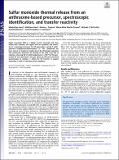| dc.contributor.author | Martin-Drumel, Marie-Aline | |
| dc.contributor.author | McCarthy, Michael C. | |
| dc.contributor.author | Patterson, David | |
| dc.contributor.author | Joost, Maximilian G | |
| dc.contributor.author | Nava, Matthew Jordan | |
| dc.contributor.author | Transue, Wesley | |
| dc.contributor.author | Cummins, Christopher C | |
| dc.date.accessioned | 2019-02-27T17:01:51Z | |
| dc.date.available | 2019-02-27T17:01:51Z | |
| dc.date.issued | 2018-05 | |
| dc.date.submitted | 2018-03 | |
| dc.identifier.issn | 0027-8424 | |
| dc.identifier.issn | 1091-6490 | |
| dc.identifier.uri | http://hdl.handle.net/1721.1/120567 | |
| dc.description.abstract | Sulfur monoxide (SO) is a highly reactive molecule and thus, eludes bulk isolation. We report here on synthesis and reactivity of a molecular precursor for SO generation, namely 7-sulfin-ylamino-7-azadibenzonorbornadiene (1). This compound has been shown to fragment readily driven by dinitrogen expulsion and anthracene formation on heating in the solid state and in solution, releasing SO at mild temperatures (<100 ◦C). The generated SO was detected in the gas phase by MS and rotational spectroscopy. In solution, 1 allows for SO transfer to organic molecules as well as transition metal complexes. Keywords: microwave spectroscopy; reactive intermediate; molecular precursor; astrochemistry; sulfur monoxide | en_US |
| dc.publisher | National Academy of Sciences (U.S.) | en_US |
| dc.relation.isversionof | http://dx.doi.org/10.1073/PNAS.1804035115 | en_US |
| dc.rights | Article is made available in accordance with the publisher's policy and may be subject to US copyright law. Please refer to the publisher's site for terms of use. | en_US |
| dc.source | PNAS | en_US |
| dc.title | Sulfur monoxide thermal release from an anthracene-based precursor, spectroscopic identification, and transfer reactivity | en_US |
| dc.type | Article | en_US |
| dc.identifier.citation | Joost, Maximilian et al. “Sulfur Monoxide Thermal Release from an Anthracene-Based Precursor, Spectroscopic Identification, and Transfer Reactivity.” Proceedings of the National Academy of Sciences 115, 23 (May 2018): 5866–5871 © National Academy of Sciences | en_US |
| dc.contributor.department | Massachusetts Institute of Technology. Department of Chemistry | en_US |
| dc.contributor.mitauthor | Joost, Maximilian G | |
| dc.contributor.mitauthor | Nava, Matthew Jordan | |
| dc.contributor.mitauthor | Transue, Wesley | |
| dc.contributor.mitauthor | Cummins, Christopher C | |
| dc.relation.journal | Proceedings of the National Academy of Sciences | en_US |
| dc.eprint.version | Final published version | en_US |
| dc.type.uri | http://purl.org/eprint/type/JournalArticle | en_US |
| eprint.status | http://purl.org/eprint/status/PeerReviewed | en_US |
| dc.date.updated | 2019-02-08T14:37:04Z | |
| dspace.orderedauthors | Joost, Maximilian; Nava, Matthew; Transue, Wesley J.; Martin-Drumel, Marie-Aline; McCarthy, Michael C.; Patterson, David; Cummins, Christopher C. | en_US |
| dspace.embargo.terms | N | en_US |
| dc.identifier.orcid | https://orcid.org/0000-0002-9239-7505 | |
| dc.identifier.orcid | https://orcid.org/0000-0001-7445-5663 | |
| dc.identifier.orcid | https://orcid.org/0000-0003-2568-3269 | |
| mit.license | PUBLISHER_POLICY | en_US |
